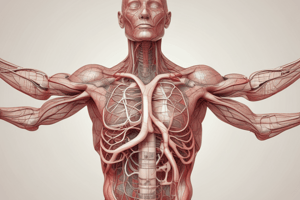Podcast
Questions and Answers
What is the function of the viscoelastic layer of the heart?
What is the function of the viscoelastic layer of the heart?
- To receive blood from the pulmonary circulation
- To secrete lubricating fluid and reduce friction (correct)
- To pump blood throughout the body
- To provide a smooth lining for the heart chambers
What is the primary role of the pericardium in the heart?
What is the primary role of the pericardium in the heart?
- To provide a smooth lining for the heart chambers
- To facilitate the flow of oxygen and nutrients to tissues
- To pump blood throughout the body
- To protect and anchor the heart (correct)
What is the function of the lymphatic vessels in the lymph vascular system?
What is the function of the lymphatic vessels in the lymph vascular system?
- To collect excess tissue fluid and transport it as lymph (correct)
- To facilitate the flow of oxygen and nutrients to tissues
- To pump blood throughout the body
- To secrete lubricating fluid and reduce friction
Which layer of the heart wall is composed of cardiac muscle cells or cardiomyocytes?
Which layer of the heart wall is composed of cardiac muscle cells or cardiomyocytes?
What is the function of the endocardium in the heart?
What is the function of the endocardium in the heart?
What is the role of the aortic valve in the heart?
What is the role of the aortic valve in the heart?
What is the primary function of the cardiovascular system?
What is the primary function of the cardiovascular system?
What type of muscle tissue is found in the heart?
What type of muscle tissue is found in the heart?
Which vessel carries deoxygenated blood back to the heart from the body's tissues?
Which vessel carries deoxygenated blood back to the heart from the body's tissues?
Which chamber of the heart receives oxygenated blood from the lungs?
Which chamber of the heart receives oxygenated blood from the lungs?
What is the function of the tricuspid valve?
What is the function of the tricuspid valve?
What is the purpose of the capillaries?
What is the purpose of the capillaries?
Flashcards are hidden until you start studying
Study Notes
Cardiovascular System
- Consists of the heart, blood vessels (arteries, veins, and capillaries), and blood
- Responsible for circulating blood, nutrients, oxygen, hormones, and waste products throughout the body
Heart
- Specialized cardiac muscle tissue
- Pumps oxygenated blood to the body and deoxygenated blood to the lungs
Blood Vessels
- Arteries: carry oxygenated blood away from the heart to various tissues and organs
- Have thick, muscular walls to withstand high pressure
- Veins: carry deoxygenated blood back to the heart from the body’s tissues
- Have thinner walls than arteries and often contain valves to prevent backflow
- Capillaries: tiny, thin-walled vessels where gas exchange and nutrient exchange occur between the blood and tissues
Four Chambers of the Heart
- Right Atrium: receives deoxygenated blood from the body via the superior and inferior vena cavae
- Right Ventricle: pumps deoxygenated blood to the lungs through the pulmonary artery
- Left Atrium: receives oxygenated blood from the lungs via the pulmonary veins
- Left Ventricle: pumps oxygenated blood to the rest of the body through the aorta
Layers of Connective Tissue in the Heart
- Myocardium: thick, middle layer of the heart wall, composed of cardiac muscle cells or cardiomyocytes
- Contracts rhythmically to pump blood throughout the body
- Striated, involuntary, highly resistant to fatigue
- Pericardium: double-layered sac that surrounds and protects the heart
- Fibrous Pericardium: outer layer of dense connective tissue that provides protection and anchorage for the heart
- Serous Pericardium: inner layer composed of two sublayers
- Parietal Layer: lines the fibrous pericardium
- Visceral Layer (Epicardium): directly covers the outer surface of the heart and is continuous with the epicardium
- Endocardium: innermost layer of the heart, consisting of endothelial cells and connective tissue
- Provides smooth lining for the chambers of the heart and covers the heart valves
- Helps reduce friction as blood flows through the heart and maintains the integrity of the heart’s structure
- Epicardium: outer layer of the heart wall, adjacent to the myocardium
- Serves as protective layer and secretes lubricating fluid that reduces friction between the heart and surrounding structures
Lymph Vascular System
- Network of vessels and organs that play a crucial role in maintaining fluid balance, immune function, and lipid absorption in the body
- Lymphatic capillaries: tiny, thin-walled vessels located throughout the body's tissues
- Collect excess tissue fluid (interstitial fluid), proteins, and cellular debris from the interstitial spaces and transport it as lymph
- Lymphatic vessels: larger vessels that collect lymph from lymphatic capillaries and transport it towards lymph nodes and eventually back into the bloodstream
- Serve as conduits for transporting lymph and immune cells throughout the body
- Have valves to prevent the backward flow of lymph and contain smooth muscle in their walls to help propel lymph forward
- Lymphatic ducts: largest lymphatic vessels that drain lymph into the venous circulation
- Return lymph to the bloodstream, primarily through two main ducts: the thoracic duct
Studying That Suits You
Use AI to generate personalized quizzes and flashcards to suit your learning preferences.




